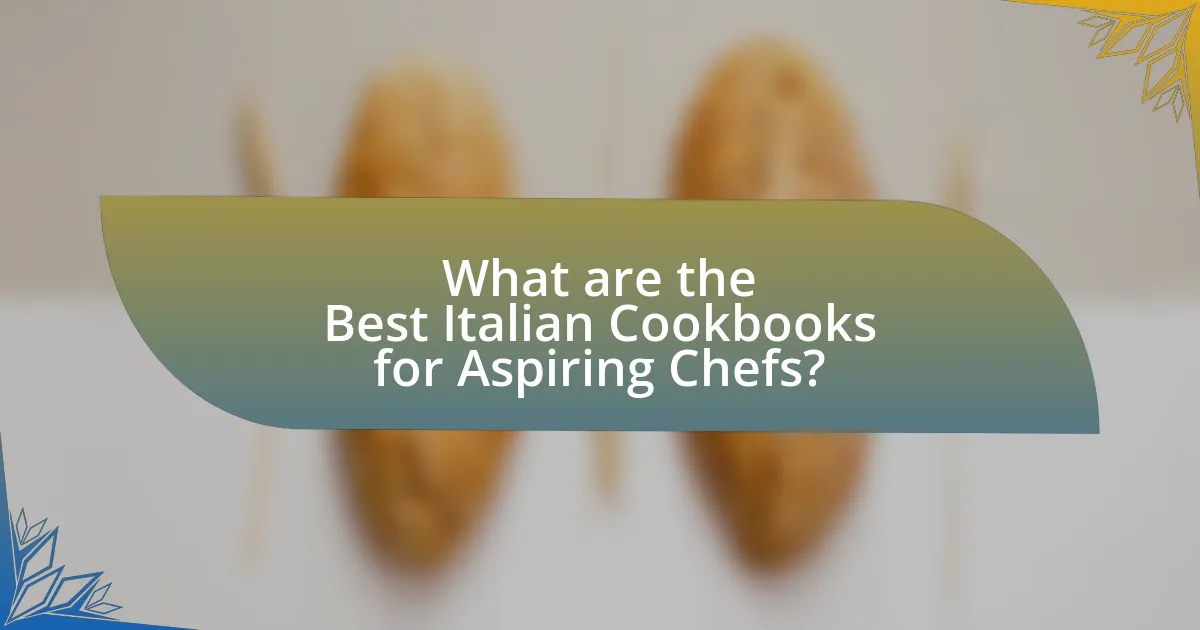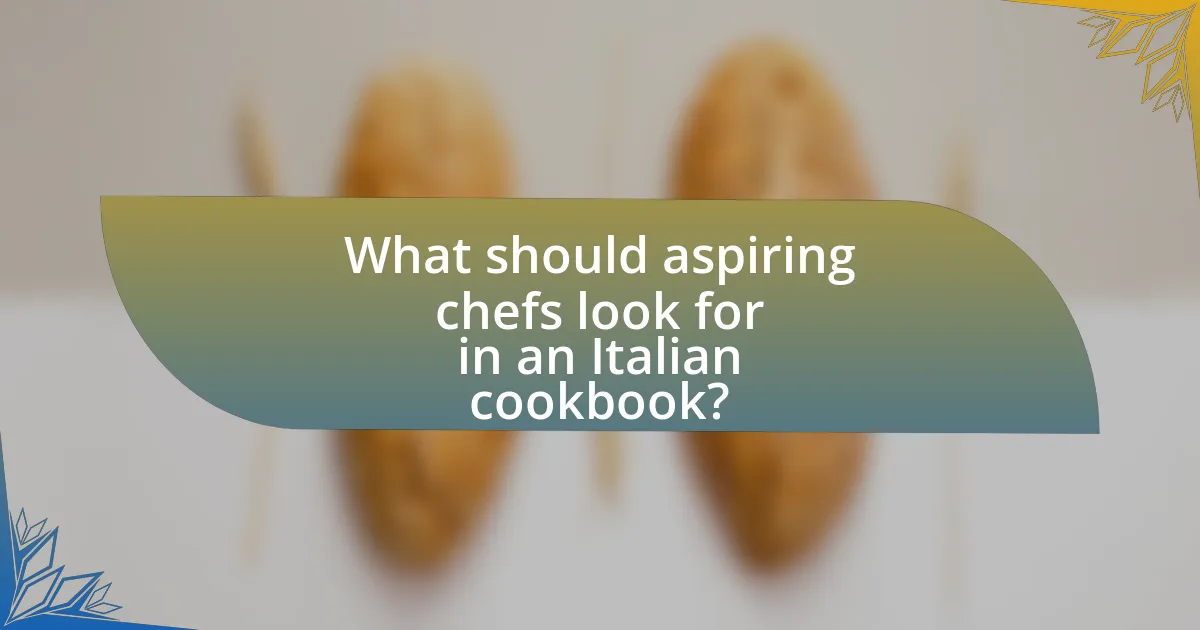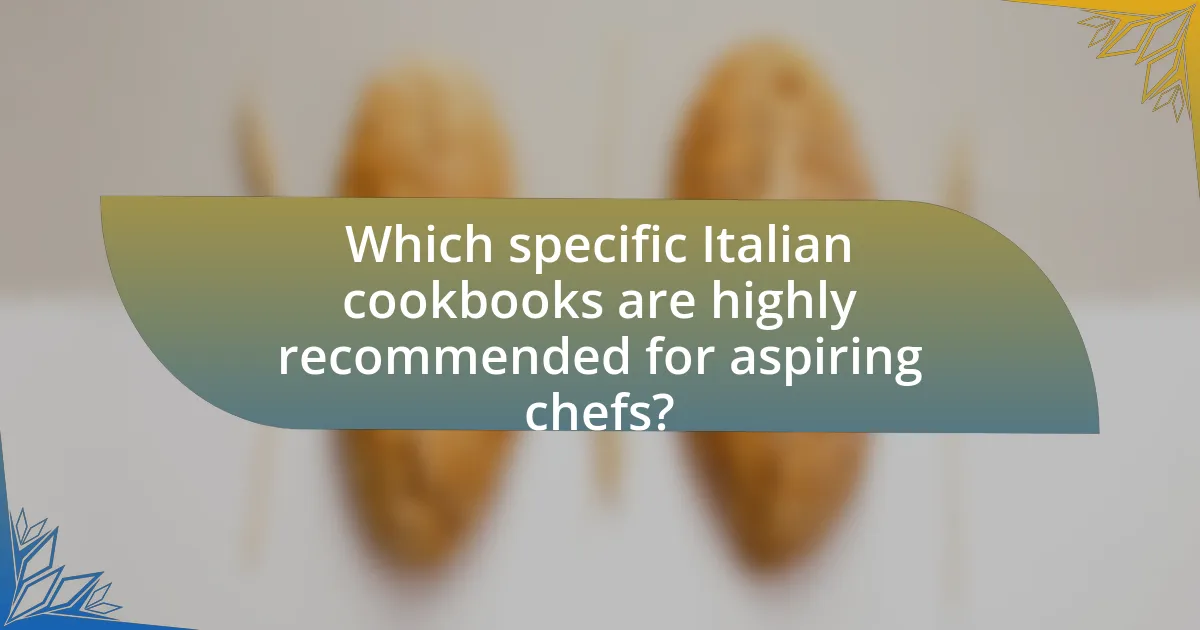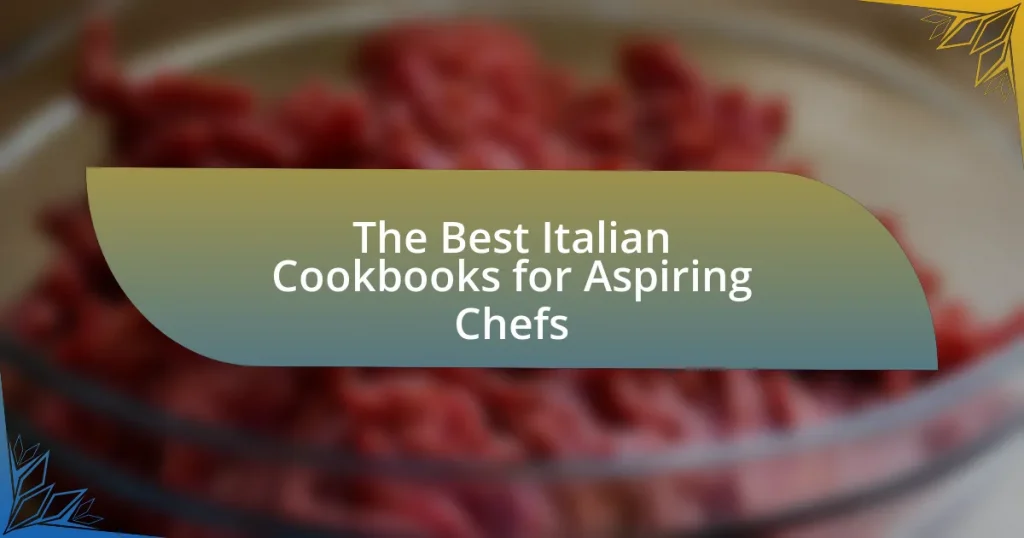The article focuses on the best Italian cookbooks for aspiring chefs, highlighting essential titles such as “Essentials of Classic Italian Cooking” by Marcella Hazan and “The Silver Spoon.” It discusses how these cookbooks cater to beginners by providing clear, step-by-step recipes and essential cooking techniques, including pasta making and sauce preparation. The article also emphasizes the importance of authenticity in Italian cooking, the role of high-quality ingredients, and offers practical tips for effectively using these cookbooks to enhance culinary skills. Additionally, it addresses common challenges faced by novice cooks and strategies to overcome them, ensuring a comprehensive resource for those looking to master Italian cuisine.

What are the Best Italian Cookbooks for Aspiring Chefs?
The best Italian cookbooks for aspiring chefs include “Essentials of Classic Italian Cooking” by Marcella Hazan, which is renowned for its comprehensive approach to traditional Italian cuisine, and “The Silver Spoon,” often referred to as the Italian culinary bible, featuring over 2,000 recipes. Another notable mention is “Italian Cooking School: Pasta” by The Silver Spoon Kitchen, focusing specifically on pasta-making techniques. These cookbooks are validated by their widespread acclaim and usage in culinary education, making them essential resources for anyone looking to master Italian cooking.
How do these cookbooks cater to beginners in Italian cooking?
These cookbooks cater to beginners in Italian cooking by providing simple, step-by-step recipes that emphasize fundamental techniques and ingredients. They often include clear instructions, visual aids, and tips for sourcing authentic ingredients, making the cooking process accessible. Additionally, many of these cookbooks feature sections dedicated to essential cooking methods, such as making pasta from scratch or preparing sauces, which are crucial for mastering Italian cuisine. This structured approach helps beginners build confidence and skills progressively, ensuring a solid foundation in Italian cooking.
What essential techniques do these cookbooks teach?
These cookbooks teach essential techniques such as pasta making, sauce preparation, and ingredient selection. Mastering pasta making involves understanding the dough’s consistency and the various shapes, which is fundamental in Italian cuisine. Sauce preparation emphasizes the balance of flavors and the use of fresh ingredients, crucial for authentic dishes. Additionally, ingredient selection focuses on sourcing high-quality, seasonal produce, which enhances the overall flavor and authenticity of Italian cooking.
Which recipes are considered must-tries for novices?
Must-try recipes for novices include Spaghetti Aglio e Olio, Caprese Salad, and Margherita Pizza. These dishes are simple yet foundational in Italian cuisine, allowing beginners to practice essential cooking techniques. Spaghetti Aglio e Olio requires only pasta, garlic, olive oil, and chili flakes, making it a quick and easy introduction to cooking. Caprese Salad, with fresh mozzarella, tomatoes, and basil, teaches novices about ingredient quality and presentation. Margherita Pizza, featuring a basic dough, tomato sauce, and fresh mozzarella, provides hands-on experience with baking and flavor balance. These recipes are widely recommended in Italian cookbooks for their accessibility and ability to build confidence in novice cooks.
Why is Italian cuisine popular among aspiring chefs?
Italian cuisine is popular among aspiring chefs due to its emphasis on fresh ingredients, simplicity, and rich flavors. This culinary tradition allows chefs to explore a variety of techniques and regional specialties, making it an ideal foundation for developing cooking skills. The use of high-quality, seasonal produce and traditional methods, such as handmade pasta and wood-fired pizza, provides a hands-on learning experience. Additionally, Italian cuisine’s global recognition and appeal encourage chefs to master its techniques, as it is often featured in culinary schools and professional kitchens worldwide.
What are the key characteristics of Italian cooking?
Italian cooking is characterized by its emphasis on fresh, high-quality ingredients, simplicity, and regional diversity. The use of seasonal produce, olive oil, and herbs like basil and oregano is fundamental, reflecting the Mediterranean diet. Traditional techniques, such as slow cooking and handmade pasta, highlight the importance of craftsmanship in Italian cuisine. Additionally, Italian cooking often features bold flavors achieved through the use of garlic, tomatoes, and cheese, particularly Parmesan and mozzarella. The regional variations, such as the rich sauces of the north and the lighter, tomato-based dishes of the south, further illustrate the diversity within Italian culinary traditions.
How does Italian cuisine influence culinary trends worldwide?
Italian cuisine significantly influences culinary trends worldwide by popularizing ingredients, techniques, and dishes that emphasize simplicity and quality. The global adoption of pasta, pizza, and risotto showcases how Italian cooking has shaped menus across various cultures, leading to the proliferation of Italian restaurants and adaptations in local cuisines. For instance, the rise of artisanal pizza in the United States reflects a growing appreciation for authentic Italian methods, such as using high-quality flour and traditional wood-fired ovens. Additionally, the Mediterranean diet, rooted in Italian culinary practices, has gained recognition for its health benefits, prompting a shift towards fresh, seasonal ingredients in global cooking. This influence is further evidenced by the increasing availability of Italian cookbooks, which serve as resources for aspiring chefs to learn and replicate these beloved dishes and techniques.

What should aspiring chefs look for in an Italian cookbook?
Aspiring chefs should look for authenticity, clarity, and a variety of recipes in an Italian cookbook. Authenticity ensures that the recipes reflect traditional Italian cooking methods and ingredients, which is crucial for mastering the cuisine. Clarity in instructions allows chefs to easily follow the steps without confusion, enhancing their cooking experience. A variety of recipes, including regional dishes and different cooking techniques, provides a comprehensive understanding of Italian cuisine, enabling chefs to explore and expand their culinary skills.
How do ingredients and authenticity play a role in cookbook selection?
Ingredients and authenticity are crucial factors in cookbook selection, particularly for Italian cuisine, as they ensure the recipes reflect traditional methods and flavors. Authentic Italian cookbooks often emphasize the use of high-quality, regional ingredients, which are essential for achieving genuine taste and culinary experience. For instance, a cookbook that highlights the use of San Marzano tomatoes or Parmigiano-Reggiano cheese provides readers with specific guidance on sourcing ingredients that are integral to authentic Italian dishes. This focus on authenticity not only enhances the cooking experience but also preserves cultural heritage, making it vital for aspiring chefs to choose cookbooks that prioritize these elements.
What types of ingredients are commonly featured in these cookbooks?
Italian cookbooks commonly feature ingredients such as pasta, olive oil, tomatoes, garlic, and fresh herbs like basil and oregano. These ingredients are foundational to Italian cuisine, with pasta serving as a staple carbohydrate, olive oil as a primary fat source, and tomatoes providing acidity and sweetness. Garlic enhances flavor, while fresh herbs contribute aromatic qualities. The prevalence of these ingredients is supported by their frequent use in traditional Italian recipes, highlighting their importance in achieving authentic flavors.
Why is authenticity important in Italian cooking?
Authenticity is important in Italian cooking because it preserves the cultural heritage and traditional techniques that define the cuisine. Authentic Italian cooking relies on regional ingredients and methods that have been passed down through generations, ensuring that the flavors and dishes remain true to their origins. For example, the use of specific local ingredients like San Marzano tomatoes or Parmigiano-Reggiano cheese not only enhances the taste but also reflects the geographical and historical context of the dishes. This adherence to authenticity fosters a deeper appreciation for the culinary art and maintains the integrity of Italian gastronomy.
What formats do the best Italian cookbooks come in?
The best Italian cookbooks come in various formats, including print, eBook, and audiobook. Print cookbooks are widely popular for their tactile experience and visual appeal, often featuring high-quality images and detailed layouts. eBooks provide convenience and portability, allowing users to access recipes on multiple devices. Audiobooks offer a unique way to learn cooking techniques through narration, making them accessible while multitasking. Each format caters to different preferences, ensuring that aspiring chefs can choose the one that best suits their cooking style and lifestyle.
How do traditional print cookbooks compare to digital versions?
Traditional print cookbooks offer a tactile experience and aesthetic appeal that digital versions lack, while digital cookbooks provide convenience and accessibility. Print cookbooks allow users to physically flip through pages, often enhancing the cooking experience through sensory engagement, which studies suggest can improve retention of information. In contrast, digital cookbooks can be accessed on multiple devices, often include interactive features like video tutorials, and allow for easy searching and bookmarking, making them more user-friendly for quick reference. According to a survey by the Pew Research Center, 29% of Americans prefer using printed cookbooks for recipes, highlighting the enduring popularity of print despite the rise of digital formats.
What are the advantages of using video tutorials alongside cookbooks?
Using video tutorials alongside cookbooks enhances the learning experience by providing visual and auditory guidance that complements written instructions. Video tutorials demonstrate techniques, such as knife skills or cooking methods, which can be difficult to convey through text alone. Research indicates that 65% of people are visual learners, meaning they retain information better when it is presented visually. Additionally, video tutorials allow for real-time demonstrations, enabling viewers to see the exact timing and consistency needed for various cooking processes, which can lead to improved outcomes in the kitchen.

Which specific Italian cookbooks are highly recommended for aspiring chefs?
The specific Italian cookbooks highly recommended for aspiring chefs include “Essentials of Classic Italian Cooking” by Marcella Hazan, “The Silver Spoon” (Il Cucchiaio d’Argento), and “Italian Cooking School: Pasta” by The Culinary Institute of America. “Essentials of Classic Italian Cooking” is considered a foundational text that covers traditional recipes and techniques, while “The Silver Spoon” is often referred to as the Italian culinary bible, featuring over 2,000 recipes. “Italian Cooking School: Pasta” focuses specifically on pasta-making, providing detailed instructions and insights into this essential Italian dish. These cookbooks are recognized for their authenticity and comprehensive approach to Italian cuisine, making them invaluable resources for aspiring chefs.
What are the top-rated Italian cookbooks available today?
The top-rated Italian cookbooks available today include “Essentials of Classic Italian Cooking” by Marcella Hazan, “The Silver Spoon” by Phaidon Press, and “Italian Cooking School: Pasta” by The Culinary Institute of America. “Essentials of Classic Italian Cooking” is renowned for its comprehensive approach to traditional Italian recipes, while “The Silver Spoon” is often referred to as the bible of Italian cooking, featuring over 2,000 recipes. “Italian Cooking School: Pasta” focuses specifically on pasta-making techniques and recipes, making it a valuable resource for aspiring chefs. These cookbooks are highly regarded for their authenticity, clarity, and depth of culinary knowledge.
What unique features do these cookbooks offer?
These cookbooks offer unique features such as authentic regional recipes, detailed cooking techniques, and cultural insights into Italian cuisine. For instance, many of these cookbooks include step-by-step instructions that emphasize traditional methods, ensuring that aspiring chefs can replicate the dishes accurately. Additionally, they often highlight specific ingredients native to various Italian regions, providing context and enhancing the cooking experience. This focus on authenticity and technique is supported by the inclusion of historical anecdotes and tips from renowned chefs, which enrich the reader’s understanding of Italian culinary traditions.
How do user reviews influence the popularity of these cookbooks?
User reviews significantly influence the popularity of cookbooks by shaping potential buyers’ perceptions and decisions. Positive reviews enhance credibility and attract more readers, as evidenced by a study from the Journal of Consumer Research, which found that products with higher ratings are more likely to be purchased. Additionally, user feedback often highlights specific recipes or techniques that resonate with readers, further driving interest and sales. This correlation between user reviews and cookbook popularity underscores the importance of consumer opinions in the culinary market.
How can aspiring chefs effectively use these cookbooks?
Aspiring chefs can effectively use these cookbooks by following structured recipes, practicing techniques, and understanding ingredient pairings. By meticulously following the step-by-step instructions provided in the cookbooks, chefs can develop their cooking skills and gain confidence in the kitchen. Additionally, many Italian cookbooks include sections on fundamental techniques, which are essential for mastering various cooking methods. Understanding ingredient pairings, as highlighted in these cookbooks, allows chefs to create balanced and flavorful dishes, enhancing their culinary repertoire.
What strategies can enhance the learning experience from cookbooks?
To enhance the learning experience from cookbooks, aspiring chefs should actively engage with the material by practicing recipes, taking notes, and experimenting with variations. Engaging with recipes through hands-on practice solidifies understanding of techniques and ingredients, while note-taking helps retain key concepts and personal insights. Experimenting with variations encourages creativity and deeper comprehension of flavor profiles and cooking methods. Research indicates that active learning strategies, such as these, significantly improve retention and skill acquisition in culinary education.
How can aspiring chefs adapt recipes to their personal tastes?
Aspiring chefs can adapt recipes to their personal tastes by modifying ingredients, adjusting cooking techniques, and experimenting with flavors. For instance, they can substitute herbs or spices to align with their preferences, such as using basil instead of oregano or adding more garlic for a stronger flavor. Additionally, they can alter cooking methods, like grilling instead of baking, to achieve different textures and tastes. Research indicates that personalizing recipes not only enhances enjoyment but also fosters creativity in cooking, allowing chefs to develop their unique culinary style.
What common challenges do aspiring chefs face when using Italian cookbooks?
Aspiring chefs commonly face challenges such as ingredient availability, recipe complexity, and cultural nuances when using Italian cookbooks. Ingredient availability can be an issue, as authentic Italian recipes often require specific items that may not be easily found in local markets. Recipe complexity poses another challenge, as many Italian dishes involve intricate techniques and multiple steps that can overwhelm beginners. Additionally, cultural nuances, including understanding regional variations and traditional cooking methods, can lead to misinterpretation of recipes, making it difficult for aspiring chefs to achieve authentic results.
How can these challenges be overcome?
To overcome challenges in mastering Italian cooking, aspiring chefs should utilize comprehensive cookbooks that provide clear instructions and authentic recipes. For instance, cookbooks like “Essentials of Classic Italian Cooking” by Marcella Hazan offer detailed techniques and cultural context, which help in understanding the nuances of Italian cuisine. Additionally, engaging in hands-on practice and seeking feedback from experienced cooks can further enhance skills and confidence in the kitchen.
What tips can help improve cooking skills while using these cookbooks?
To improve cooking skills while using Italian cookbooks, practice consistently by following recipes step-by-step. This hands-on approach allows for the development of techniques and familiarity with ingredients. Additionally, take notes on personal adjustments and outcomes to refine methods over time. Research indicates that active engagement in cooking, such as experimenting with variations of recipes, enhances skill retention and culinary understanding.














